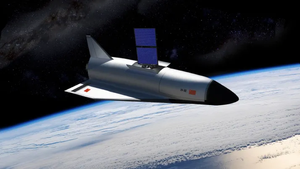
Mar 27, 2024
A Railgun Launched Chinese Spaceplane
The Chinese National Manned Space Administration was given the designation of Project 921 in 1992. This project was then segmented into three core phases, This included China launching their own crewed mission, a temporary space station, and then a permanent one. Among the considered crewed spacecrafts included the Soyuz style Shenzhou which won out were several spaceplane designs. This is where we can see the emergence of spaceplanes within China's space program.
On December 11, 2007, pictures of a mysterious aircraft were uploaded to several domestic military websites. The aircraft was mounted on an H-6, and its surface was painted with a five-star red flag and the words 'Shenlong' (神龙) meaning divine dragon. In more recent times there's been reports of a Chinese spaceplane that seems to fulfill similar roles to the USA's X-37B and is believed to share a large amount of commonality with Shenlong.

Yet there has been a more recent development within China's spaceflight program in regards to spaceplanes and it has the potential to be revolutionary!
In the imminent horizon, the prospect of human space travel takes a quantum leap as visionary Chinese scientists and engineers orchestrate an extraordinary convergence of cutting-edge electromagnetic launch and hypersonic flight technologies. Picture this visionary endeavor: A colossal electromagnetic launch track poised to propel a hypersonic aircraft to the dizzying velocity of Mach 1.6. Upon disengagement from the track, the aircraft ignites its engines, hurtling into the celestial realm at a breathtaking seven times the speed of sound.
The celestial titan: a majestic space plane, boasting a formidable mass of 50 tonnes and surpassing the dimensions of a Boeing 737 airliner. This marvel of engineering represents a cornerstone of the illustrious "Tengyun project," unveiled amidst great fanfare in the annals of 2016. Li Shaowei, a scientist with the China Aerospace Science and Industry Corporation, stated "Electromagnetic launch technology provides a promising solution to overcome these challenges and has emerged as a strategic frontier technology being pursued by the world's leading nations," Li’s team has conducted computer simulations and wind tunnel tests. Their findings have revealed that as the aircraft breaches the sound barrier, numerous shock waves ripple along its underside, colliding with the ground and generating a cascade of reflections. These tests are crucial and show that China is very serious about the development of key Aerospace technology.
Other aspects of Tengyun shown off via models at presentations, animations, and slideshows have depicted Tengyun as a two stage spaceplane concept with a carrier aircraft acting as the first stage. This would look similar to as depicted below

The Chinese spaceplane endeavors however are still early in their development. Meaning multiple avenues are most likely being considered and explored. This is comparable to how NASA takes bids from contractors while funding the research in feasibility studies. NASA has done this with the Space Shuttle, the USAF has done this with fighter jets so the diverse range of proposals out there is not unheard of within this realm of aerospace.
China is not the first organization to consider rail launched spaceplane however and there is a long historical context on why it has not been done yet.

The German winged orbital launch vehicle, studied by MBB from 1962 to 1969, represents the culmination of Eugen Saenger's visionary concept for a spaceplane. This final iteration of the Saenger spaceplane envisioned the utilization of a rocket-propelled sled for horizontal launch, deploying delta-winged, rocket-propelled first and second stages. Alternatively, an alternate version considered vertical launch with horizontal landing, employing a two-stage winged launch vehicle. Although this project remained at the study stage, it epitomized Saenger's lifelong dream of manned winged spaceflight.
The RT-8 sled operated through a steam rocket propulsion system, catapulting the first and second stages along a 3-kilometer track to achieve a release velocity of 900 kilometers per hour. An alternative launch approach involved utilizing a heavily modified B-52 bomber for a subsonic air release. Both stages were equipped with Lox/LH2 engines, each boasting a sea-level thrust of 50 metric tons and a specific impulse of 430 seconds. Following lift-off, the first stage ascended to a 60-kilometer altitude within 150 seconds, subsequently releasing the second stage before gliding back to the base. The second stage then proceeded to achieve a 300-kilometer altitude orbit. Notably, the first stage featured a shoulder-mounted delta wing with drooped wingtips, resembling the compression lift characteristics of the XB-70 bomber, while the upper stage mirrored this design in reverse, sporting a low-mounted seventy-degree double-delta wing with upturned tips akin to the X-20 Dynasoar.
Yet spaceplanes have been largely confined to paper studies as costly testing facilities, computer simulations, modern day composites, advancements in material manufacturing were simply not available to these researchers. However they paved the way for concepts like what China is studying right now.
Within the domain of electromagnetic space launch systems, China stands as a pioneering force, wielding distinct advantages that set it apart from other nations. Prominent defense entities such as CASIC have not only engineered their own hypersonic weapons but have seamlessly integrated them into the formidable arsenal of the People’s Liberation Army (PLA), concurrently fostering substantial revenue streams for their originators.
Moreover, China's preeminence in electromagnetic rail gun research is irrefutable, underscored by groundbreaking achievements encompassing the refinement of high-performance power supplies, mastery of precision control technology, formulation of resilient wear-resistant coatings, and the innovation of electronic components endowed with unparalleled resilience against potent electromagnetic interference. In essence, China's strategic investments and relentless pursuit of technological excellence have propelled it to the forefront of electromagnetic space launch endeavors, establishing a formidable lead that remains unparalleled on the global stage.
Various Chinese spaceplane projects are in different stages of development, ranging from conceptualization to the creation of functional prototypes. CALT has spearheaded the design of at least three spaceplanes since 2016, potentially including the one tested in July, while others have emerged from aerospace startups established within the past five years. Notably, unlike the Shenlong, all these newer projects, including Tengyun, are officially designated for commercial applications.
One of the primary advantages of spaceplanes lies in their reusability, which holds the potential to significantly diminish the expenses associated with space missions. Moreover, spaceplanes boast superior maneuverability in orbit, enabling them to undertake a broader array of missions and execute multiple tasks within a single mission. Additionally, horizontal-takeoff spaceplanes like Tengyun are well-suited for endeavors such as space tourism and point-to-point transportation, as they can depart from conventional airports and provide smoother journeys compared to traditional rockets. While the realization of hypersonic civil aviation may be distant, China's luxury space tourism sector is forecasted to reach $401.6 million by 2027.
These very attributes have piqued the interest of both the U.S. and Chinese militaries. Beyond cost reduction, spaceplanes possess the capability to linger and maneuver in orbit for extended durations with minimal fuel consumption, thereby enhancing their operators' intelligence, surveillance, and reconnaissance (ISR) capabilities, as well as their communication networks. Furthermore, they could potentially be employed for orbital strikes against adversary satellites, aircraft, or ground targets, leveraging their speed and agility to outpace ground-based missile systems and evade conventional defenses. Consequently, the distinction between spaceplanes and hypersonic orbital gliders becomes increasingly blurred.
In conclusion, while the realization of spaceplanes remains a multifaceted journey characterized by technological challenges and strategic considerations, China's proactive endeavors signal a paradigm shift in the aerospace landscape. With visionary fervor driving innovation and strategic foresight shaping applications, the trajectory of spaceplane development is poised for revolutionary ascent.



